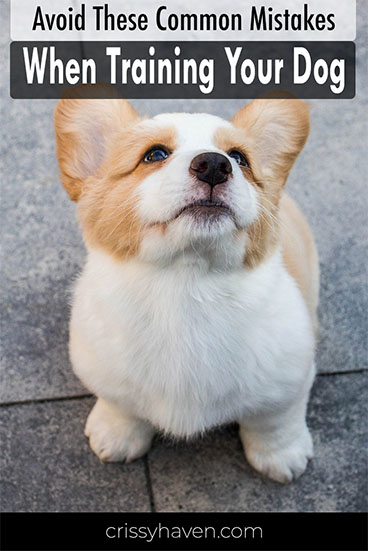So you just brought home a new Border Collie pup, huh? That’s great! Border Collies are incredibly smart and energetic dogs, perfect for anyone looking for an active and intelligent companion. But let me ask you something – have you started their training yet? If not, don’t worry, I’m here to help you out. In this article, we’re going to discuss some common mistakes that people make when training their Border Collies, so you can avoid them and set your furry friend up for success.
When it comes to Border Collie training, one of the biggest mistakes people make is not being consistent. These dogs thrive on routine and structure, so it’s important to establish clear boundaries and expectations right from the start. Make sure everyone in your household is on the same page and using the same commands and techniques. Consistency also applies to the timing and frequency of training sessions. Set aside dedicated time each day for training, and stick to it. It may take some time and patience, but your Border Collie will learn best when they can predict and depend on the training routine.
Another common mistake is failing to provide enough mental and physical stimulation. Border Collies are intelligent and active dogs, and if they don’t have enough outlets for their energy and mental stimulation, they can become frustrated and exhibit destructive behaviors. It’s important to give them plenty of physical exercise through walks, runs, or playtime in a secure area. Additionally, mental stimulation is just as important. Use puzzle toys, obedience exercises, and interactive games to challenge their minds and keep them engaged. A tired Border Collie is a well-behaved Border Collie, so make sure to provide them with the mental and physical exercise they need.
If you want to learn more about effective Border Collie training and how to avoid other common mistakes, make sure to check out the full article. You’ll find valuable tips and techniques that will help you and your furry friend build a strong and successful training relationship.
Choosing the Right Training Method
When it comes to training your Border Collie, it’s important to choose the right method that will help them learn and thrive. Positive reinforcement is widely recommended as an effective training technique for Border Collies and most dogs in general. This method involves rewarding good behaviors rather than punishing bad ones.
Understanding Positive Reinforcement
Positive reinforcement involves using rewards, such as treats, praise, or petting, to encourage desired behaviors in your Border Collie. For example, when teaching them to sit, you can reward them with a treat when they successfully sit on command. This positive experience helps to reinforce the behavior and they will be more likely to repeat it in the future.
Avoiding Harsh Punishments
While it’s important to discipline your Border Collie and correct unwanted behaviors, it’s crucial to avoid using harsh punishments. This includes yelling, physical force, or any form of aggression towards your dog. Not only can these methods cause fear and anxiety in your Collie, but they can also damage your relationship with them. Instead, focus on redirecting their attention to more appropriate behaviors and using positive reinforcement to encourage good behavior.
Considering Professional Training Services
If you’re unsure about how to properly train your Border Collie or if you’re facing challenges that you can’t seem to overcome on your own, it may be beneficial to consider professional training services. Professional trainers have the knowledge and experience to address specific training issues and can provide guidance and support to help you and your Collie succeed.
Understanding Border Collie Behavior
Border Collies are highly intelligent and energetic dogs. Understanding their behavior is crucial for effective training and a happy, well-behaved pet.
The Importance of Mental Stimulation
Border Collies require mental stimulation to prevent boredom and the development of destructive behaviors. This breed thrives on learning and problem-solving activities. Incorporating puzzle toys, interactive games, and obedience training into their daily routine can help keep their minds sharp and engaged.
Addressing Separation Anxiety
Border Collies are known to be prone to separation anxiety. This can cause destructive behavior, excessive barking, and even self-harm when left alone. Gradual desensitization, crate training, and providing engaging toys and treats can help alleviate their anxiety and teach them that being alone is not something to fear.
Dealing with Excessive Barking
Border Collies are naturally protective and vocal, which can lead to excessive barking if not properly addressed. Training them to understand when barking is appropriate and when it’s not can help keep their barking under control. Positive reinforcement techniques can be used to reward them for staying quiet in certain situations.

Establishing a Consistent Routine
A consistent routine is essential for effective training and maintaining a well-behaved Border Collie. Here are some key aspects to consider when establishing a routine for your furry friend.
Setting Clear Rules and Boundaries
Establishing clear rules and boundaries from the beginning is crucial for your Collie’s understanding of what behaviors are acceptable. Consistency in enforcing these rules will help them learn and follow them more effectively. For example, if you don’t allow your Collie on the furniture, it’s important to consistently reinforce this rule and redirect them to an appropriate spot.
Creating a Daily Training Schedule
Setting aside dedicated training time each day is important for your Collie’s learning and progress. This can include short training sessions throughout the day, as well as regular exercise and mental stimulation. Consistency and regularity will help reinforce good behaviors and prevent your Collie from becoming bored or restless.
Implementing Regular Exercise
Border Collies are known for their high energy levels and need for physical exercise. Regular exercise, such as daily walks, runs, or play sessions, is crucial for keeping them physically fit and mentally stimulated. A tired Collie is more likely to be attentive and responsive during training sessions.
Teaching Basic Commands
Teaching your Border Collie basic commands is a fundamental part of their training and helps establish their understanding of your expectations.
Mastering Sit, Stay, and Come
Sit, stay, and come are among the most important commands to teach your Collie. These commands provide safety, control, and help to prevent unwanted behaviors. Positive reinforcement, consistency, and patience are key when teaching these commands. Start with short training sessions in distraction-free environments and gradually increase the level of difficulty.
Teaching the Release Command
The release command, typically “okay” or “free,” is used to signal to your Collie that they are no longer restricted and can resume their normal behavior. This command is especially important when teaching the “stay” command. Consistency in using the release command will help your Collie understand when they are allowed to move again.
Training for Leash Walking
Leash walking is an essential skill for your Collie’s safety and your own. Teaching them to walk calmly on a leash without pulling requires patience and positive reinforcement. Start by familiarizing them with the leash and collar, and gradually introduce them to walking on a loose leash. Reward them for walking by your side and discourage pulling by stopping and redirecting their attention.

Socializing Your Border Collie
Socialization is crucial for your Border Collie to develop into a well-rounded and confident dog. Here are some key aspects to consider when socializing your Collie.
Introducing to New Environments
Expose your Collie to various environments, such as parks, streets, and different surfaces, to help them become comfortable and adaptable. Gradually introduce them to new experiences, ensuring positive associations and rewards for their calm and confident behavior.
Meeting Other Dogs and People
Properly socializing your Collie with other dogs and people is essential for their development and well-being. Arrange controlled encounters with friendly and well-behaved dogs and people, ensuring positive experiences and rewards for appropriate behavior. This will help prevent fear, aggression, and other behavioral issues.
Preventing Resource Guarding
Border Collies are known to exhibit resource guarding behavior, where they become possessive of their food, toys, or other belongings. Early socialization and training can help prevent or manage resource guarding. Teach your Collie to associate the presence of other dogs or people with positive outcomes, such as treats or playtime.
Agility Training for Border Collies
Agility training is an excellent way to channel your Border Collie’s energy and intelligence into a fun and challenging activity. Here’s what you need to know about agility training for your Collie.
Understanding the Breed’s Natural Abilities
Border Collies are known for being agile, quick learners, and excellent problem-solvers. They have a natural talent for agility due to their herding instincts and high energy levels. Utilize their natural abilities to engage them in agility training and provide an outlet for their energy.
Building Confidence on Obstacle Courses
Start by introducing your Collie to basic agility obstacles such as jumps and tunnels. Use positive reinforcement to encourage their confidence and willingness to navigate the obstacles. Gradually increase the difficulty level and introduce new obstacles as your Collie progresses.
Preparing for Competitions
If you and your Collie are interested in competing in agility trials, it’s essential to continue training and practice regularly. Seek guidance from professional trainers to help you refine your Collie’s skills and ensure they meet the requirements for competition.

Addressing Common Behavior Problems
Addressing common behavior problems early on is crucial for a well-behaved Border Collie. Here are some common behavior problems and how to address them.
Chewing and Destructive Behavior
Chewing is a natural behavior for dogs, but it can become a problem when they target your belongings or furniture. Provide your Collie with appropriate chew toys to redirect their chewing behavior. Ensure they have plenty of mental and physical stimulation to prevent boredom, which can lead to destructive behavior.
Jumping and Excitable Greetings
Border Collies are known for their exuberant greetings, which can include jumping up on people. Teach your Collie an alternative behavior, such as sitting, instead of jumping. Reward them for sitting calmly when greeting people and redirect their attention if they start to jump.
Herding Instinct and Nipping
Border Collies have a strong herding instinct, which can manifest as nipping or herding behavior towards people or other animals. Discourage this behavior by redirecting their attention to more appropriate activities, such as playing with toys. Training them to have a reliable recall command can also help redirect their focus when necessary.
Dealing with Fear and Anxiety
Fear and anxiety can affect any dog, including Border Collies. Recognizing and addressing these emotions is important for their well-being. Here’s how to help your Collie cope with fear and anxiety.
Recognizing Signs of Fear and Anxiety
Signs of fear and anxiety in your Collie can include trembling, hiding, excessive panting, pacing, or avoidance behaviors. Recognizing these signs is crucial for identifying the triggers and addressing the underlying causes.
Counterconditioning and Desensitization
Counterconditioning and desensitization techniques can help your Collie overcome their fears and anxieties. This involves gradually exposing them to the trigger that causes fear or anxiety in a controlled and positive manner. Reward them for calm and relaxed behavior, gradually increasing their tolerance and confidence.
Seeking Professional Help if Needed
If your Collie’s fear or anxiety is severe or persists despite your efforts, it may be necessary to seek professional help. A professional dog trainer or a veterinary behaviorist can provide guidance and develop a tailored plan to address your Collie’s specific needs.

The Benefits of Positive Reinforcement
Positive reinforcement is a training technique that rewards desired behaviors, leading to a strong bond and effective training with your Collie.
Building a Strong Bond with Your Collie
Positive reinforcement training helps to strengthen the bond between you and your Collie. It promotes trust and encourages your Collie to view you as a source of positive experiences and rewards.
Motivating and Rewarding Desired Behaviors
Using rewards such as treats, praise, or playtime motivates your Collie to repeat desired behaviors. Positive reinforcement helps to reinforce good behaviors, making them more likely to occur again in the future.
Creating a Positive Training Experience
Positive reinforcement training creates a positive learning environment for your Collie. It focuses on rewards and encouragement, which enhances their enjoyment and willingness to learn. This positive experience leads to faster and more effective training results.
Avoiding Common Training Mistakes
To ensure successful training, it’s important to avoid common mistakes that can hinder your Collie’s progress. Here are some mistakes to avoid.
Inconsistency and Lack of Patience
Consistency is key when training your Collie. Inconsistency in enforcing rules or commands can confuse your Collie and slow down their learning progress. Patience is also crucial, as it may take time for your Collie to understand and learn new commands or behaviors.
Neglecting Mental Stimulation
Border Collies have highly active minds and need mental stimulation to prevent boredom-related behavioral problems. Neglecting mental stimulation can lead to restlessness, anxiety, and destructive behaviors. Incorporate puzzle toys, obedience training, and interactive games into your Collie’s routine to provide mental challenges and enrichment.
Blaming the Dog for Failures
It’s important to remember that training is a learning process for both you and your Collie. It’s easy to become frustrated or blame your Collie when progress is slow or when mistakes occur. However, training is a partnership, and taking responsibility for your actions and adjusting your approach when necessary is crucial for success.

Understanding Border Collie Body Language
Understanding your Collie’s body language is vital for effective communication and recognizing their emotions. Here are some key indicators to look for.
Signs of Relaxed and Comfortable State
A relaxed Collie will have loose body posture, a wagging tail, and soft, relaxed facial expressions. They may also lie down or rest peacefully. These signs indicate that your Collie is comfortable and content.
Indications of Stress or Discomfort
Stress or discomfort can be indicated by a tense body posture, a tucked tail, flattened ears, or dilated pupils. Your Collie may also pant excessively or show signs of avoidance or withdrawal. If you notice these signs, it’s important to evaluate the situation and make necessary adjustments to ensure your Collie’s well-being.
Interpreting Tail Wagging and Eye Contact
Tail wagging and eye contact can convey different messages depending on the context. A loose and relaxed tail wag usually indicates happiness and excitement, whereas a stiff and rapid wag may indicate anxiety or aggression. Similarly, direct and soft eye contact can show attentiveness and trust, while hard and intense eye contact can be a sign of challenge or aggression.
Training for Recall and Off-Leash Control
A reliable recall command and off-leash control are important for your Collie’s safety and freedom. Here’s how to train them effectively.
Building a Strong Recall Command
Start by training your Collie to respond to their name, using positive reinforcement. Gradually introduce the recall command, such as “come” or “here,” while rewarding them for responding promptly. Start in a controlled environment and gradually increase the level of distractions.
Proofing Recall in Different Environments
Once your Collie understands and reliably responds to the recall command in a controlled environment, it’s important to proof their response in different environments. Practice in various locations, gradually increasing the level of distractions, to ensure your Collie will come back to you regardless of the circumstances.
Maintaining Off-Leash Control
Off-leash control requires trust, consistency, and ongoing practice. Gradually increase the amount of time your Collie spends off-leash, always ensuring they are in a safe and controlled environment. Use positive reinforcement to reward them for staying close and listening to your commands, while addressing any instances of disobedience with firm redirection.
Training Collar and Leash Etiquette
Proper collar and leash usage is crucial for your Collie’s comfort, safety, and effective training.
Choosing the Right Collar and Leash
Selecting the right collar and leash for your Collie is important for their well-being. Consider factors such as size, material, and your Collie’s behavior when choosing a collar or harness. A well-fitted collar or harness should allow two fingers to be comfortably inserted between it and your Collie’s neck.
Proper Fit and Usage
Ensure that the collar or harness is properly fitted and adjusted to prevent discomfort or injury. Use a sturdy leash of appropriate length for control and safety during walks or training sessions. Avoid using retractable leashes for training, as they can create inconsistent feedback and make it harder to maintain control.
Avoiding Leash Pulling and Choking
Leash pulling can cause discomfort for your Collie and make walks unpleasant for both of you. Train your Collie to walk calmly on a loose leash using positive reinforcement techniques and redirect their attention if they start to pull. Avoid using collars that can cause choking, such as choke or prong collars, as they can lead to physical harm and negatively impact your Collie’s well-being.
Conclusion
Training your Border Collie can be a rewarding and fulfilling experience. By avoiding common training mistakes and implementing positive reinforcement techniques, you can build a strong bond with your Collie while helping them become a well-behaved companion. Remember to be patient, consistent, and always prioritize their mental and physical well-being. With dedication and the right approach, you and your Collie can achieve training success and enjoy a lifetime of adventures together.
